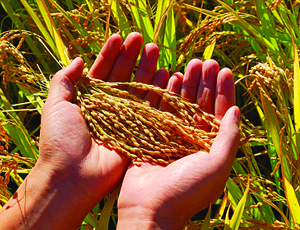Harvesting
Harvesting Process
Methods of growing differ greatly in different localities, but in most Asian countries the traditional hand methods of cultivating and harvesting rice are still practiced.
The fields are prepared by plowing (typically with simple plows drawn by water buffalo), fertilizing (usually with dung or sewage), and smoothing (by dragging a log over them). The seedlings are started in seedling beds and, after 30 to 50 days, are transplanted by hand to the fields, which have been flooded by rain or river water. During the growing season, irrigation is maintained by dike-controlled canals or by hand watering. The fields are allowed to drain before cutting.

Manual Harvesting Process
In many countries rice ears are cut by hand. A special knife is frequently used in SouthEast Asia (“ani-ani”). For instance, in the Casamance region of Senegal rice is cut stem by stem with a knife, 10 cm below the panicle so as to leave straw in the field in amounts large enough to produce grazing for cattle. Nevertheless such practice is labor intensive.
Machanization Harvesting
In many countries rice ears are cut by hand. A special knife is frequently used in SouthEast Asia (“ani-ani”). For instance, in the Casamance region of Senegal rice is cut stem by stem with a knife, 10 cm below the panicle so as to leave straw in the field in amounts large enough to produce grazing for cattle. Nevertheless such practice is labour intensive.
During past decades the mechanization of rice harvesting has rapidly evolved. The first machines used were simple animal-drawn or tractor-driven moving machines fitted with a cutter bar. The improvements made on this equipment have first resulted in the development of swathe. These drop the crop in a continuous windrow to the side of the machine making it easy to pick up the panicles and manually tie them into bundles. The next step forward has been the reaper that forms unbound sheaves; and finally the reaper/binder which has a tying device to produce sheaves bound with a twine. However the supply, cost and quality of the twine are the main problems associated with the use of such equipment.
The output of these machines varies between 4 and 10 hours per hectare, which is slow. However, they may be usefully introduced into tropical rice growing areas, where hand harvesting results in great labour problems. In temperate countries they have been gradually replaced by combine harvesters.
Traditional Threshing
The traditional threshing of rice is generally made by hand: bunches of panicles are beaten against a hard element (eg, a wooden bar, bamboo table or stone) or with a flail. The outputs are 10g to 30kg of grain per man-hour according to the variety of rice and the method applied. Grain losses amount to 1-2%, or up to 4% when threshing is performed excessively late; some unthreshed grains can also be lost around the threshing area.
In many countries in Asia and Africa, the crop is threshed by being trodden underfoot (by humans or animals); the output is 30kg to 50kg of grain per man hour. The same method, but using a vehicle (tractor or lorry) is also commonly applied.

